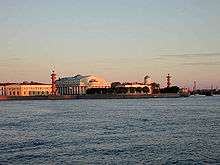Old Saint Petersburg Stock Exchange and Rostral Columns
- For the active stock exchange in Saint Petersburg, see Saint Petersburg Stock Exchange.

The Old Saint Petersburg Stock Exchange (also Bourse) and Rostral Columns, located in Saint Petersburg in the Russian Federation, are significant examples of Greek Revival architecture. Designed by French architect Thomas de Thomon, and inspired by the Greek Temple of Hera at Paestum, the stock exchange was constructed between 1805 and 1810. The rostral columns erected on either side of the Stock Exchange were completed in 1811. The Old Saint Petersburg Stock Exchange is located at Birzhevaya Ploschad 4.
Old Stock Exchange

The Old Stock Exchange is sited to fill the majestic sweep of the Spit (in Russian Strelka) of Vasilievsky Island, just opposite the Winter Palace. Thomon's design called for a peristyle of forty four Doric columns resting upon a massive stylobate of red granite and supporting an entablature of triglyphs and slotted metopes. A monumental sculptural group similar in form to a quadriga featuring Neptune, and symbolizing maritime commerce, is mounted above the portico. Both inside and outside the Bourse, a motif of the semicircle is recurrent. The interior features a large colonnaded trading hall, now divided into eight exhibition halls. The central rooms are illuminated by an oblong skylight. The surrounding ceiling features double-sunk coffers.
The Rostral Columns


Opposite the exchange building on the Neva, de Thomon designed a semicircular overlook with circular ramps descending to a jetty projecting into the river. This formal approach, is framed by two rostral columns centered on the portico of the Stock Exchange. The Doric columns sit on a granite plinth and are constructed of brick coated with a deep terra cotta red stucco and decorated with bronze anchors and four pairs of bronze ship prows (rostra). Seated marble figures decorate the base of each column each representing the major rivers of Russia — the Volga and Dnieper at the northern Rostral Column, Neva and Volkhov at the southern one. The Rostral Columns were originally intended to serve as beacons and originally were topped by a light in the form of a Greek brazier and lit by oil. The braziers have been removed and the tops of the columns refitted with gas torches that continue to be lit on ceremonial occasions.
Notes
References
- Бунин М. С. Стрелка Васильевского острова: История формирования архитектурного ансамбля. М.; Л., 1958.
- Канн П. Я. Стрелка Васильевского острова. Л., 1973.
External links
| Wikimedia Commons has media related to Spit of the Vasilievsky Island. |
- Online description of The Old Stock Exchange and the Rostral Columns
- Hermitage Museum replica of the Rostral Columns
-
.jpg)
The Old Stock Exchange (Bourse) as seen in an 1817 engraving
-

The Old Stock Exchange (Bourse) and the rostral columns in the 1890s
-

The Rostral Column and Palace Bridge
-

Portico of the Old Stock Exchange (Bourse)
Coordinates: 59°56′37″N 30°18′16″E / 59.943556°N 30.30452°E